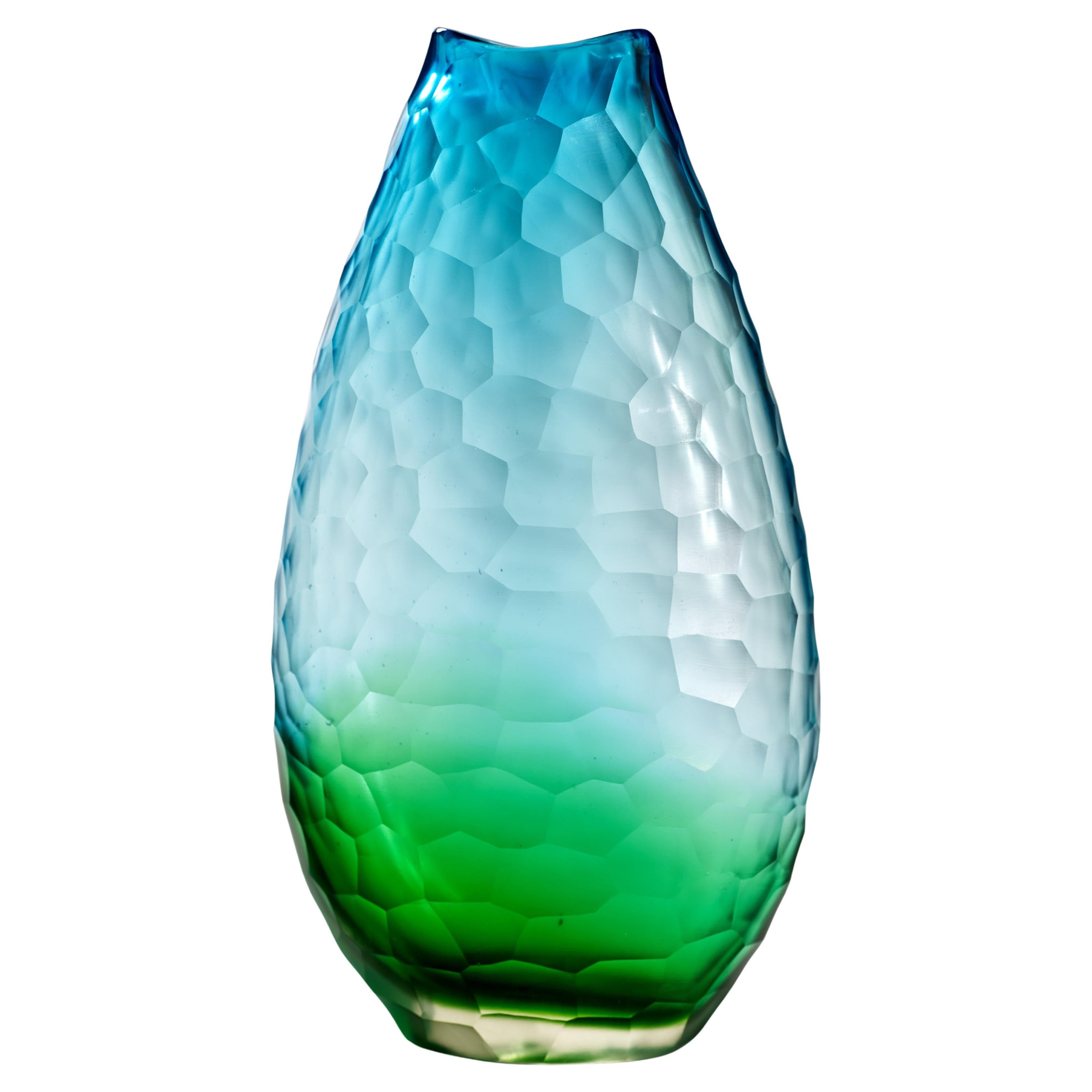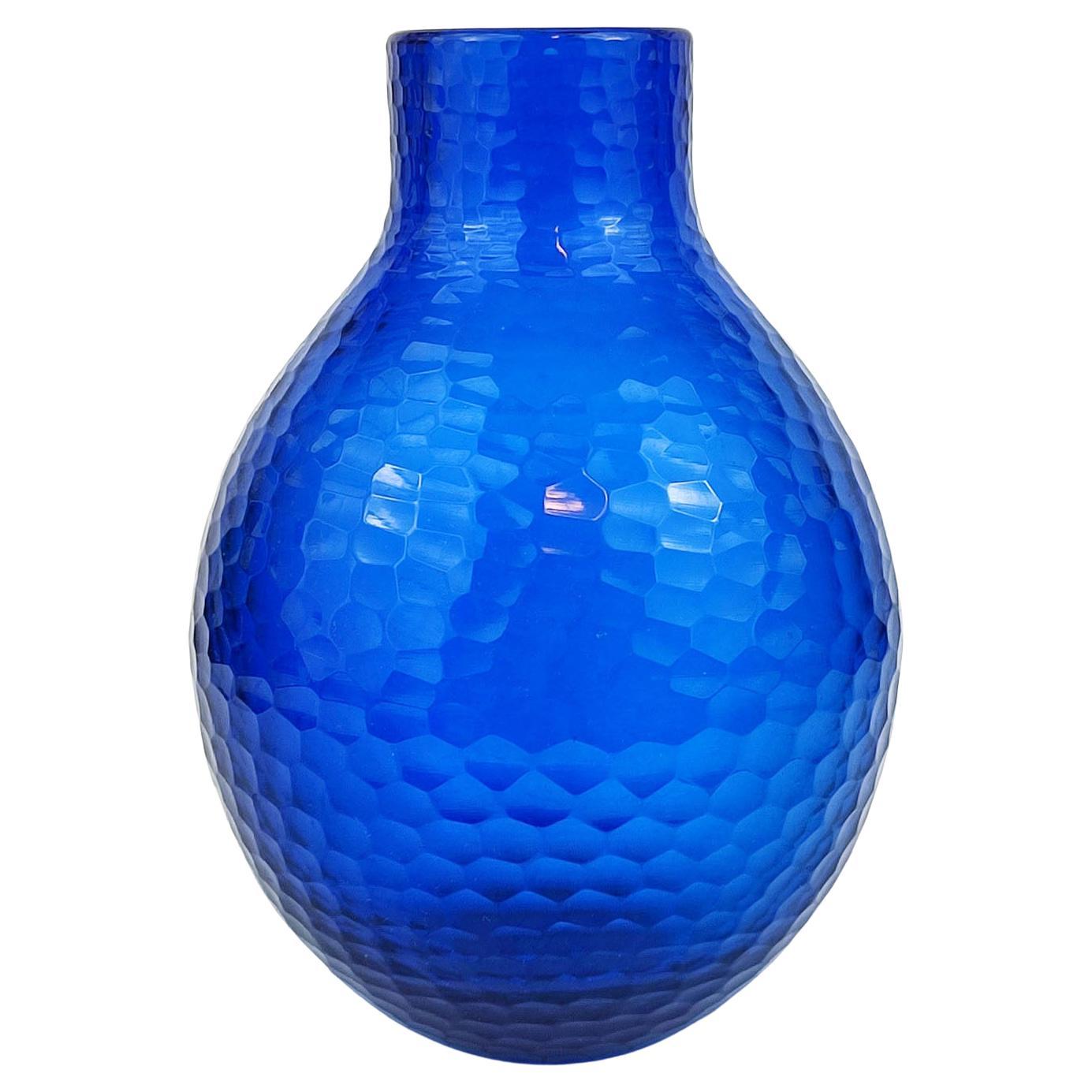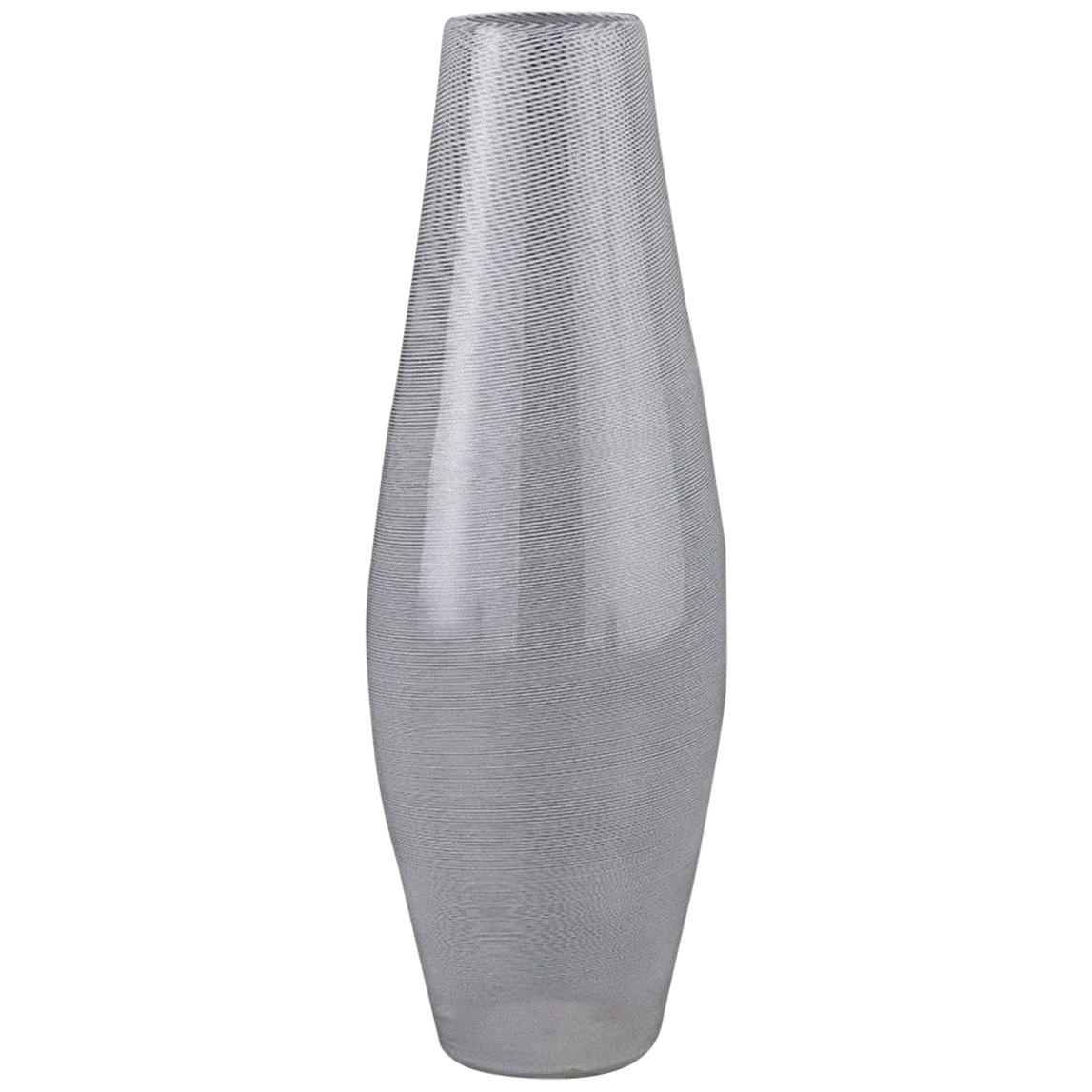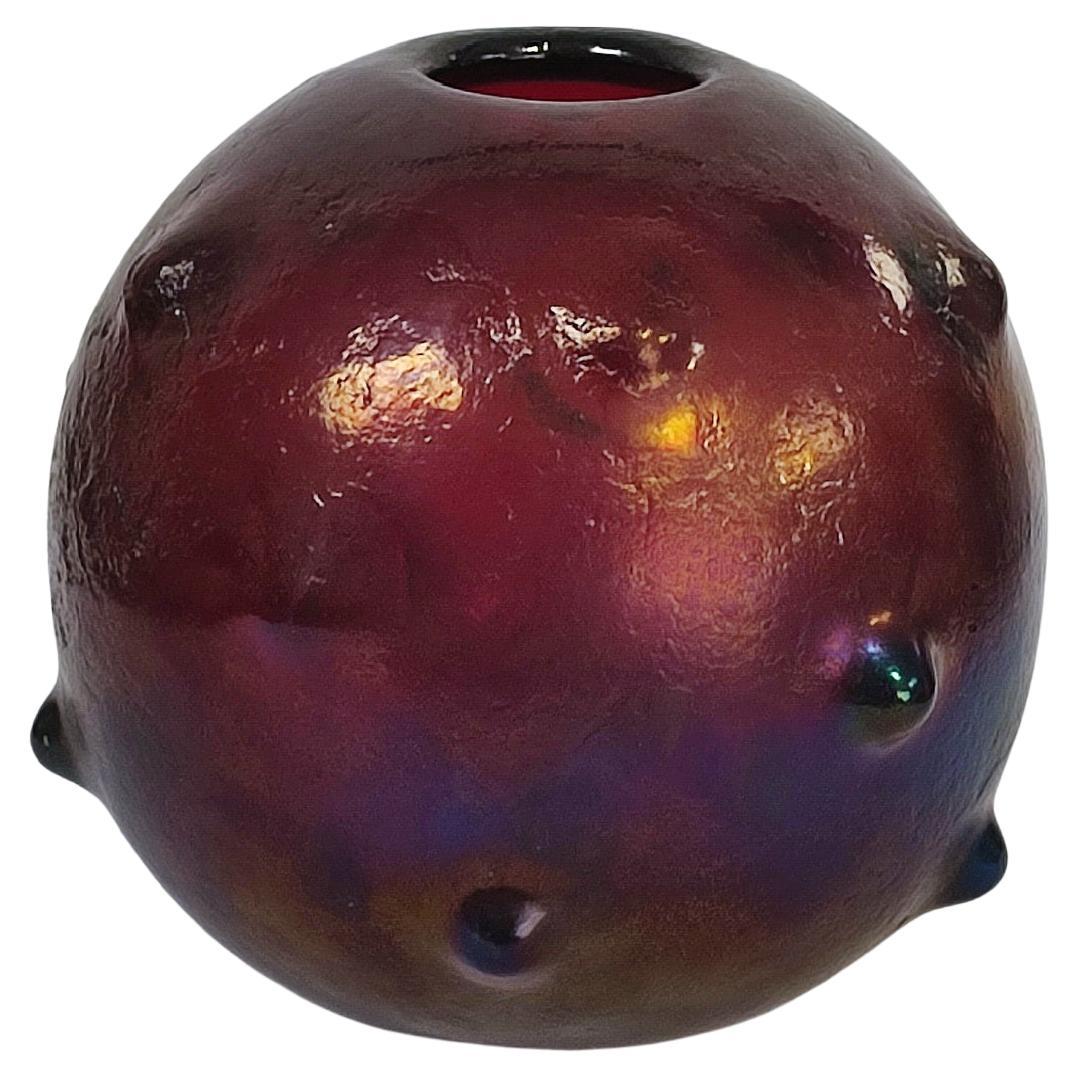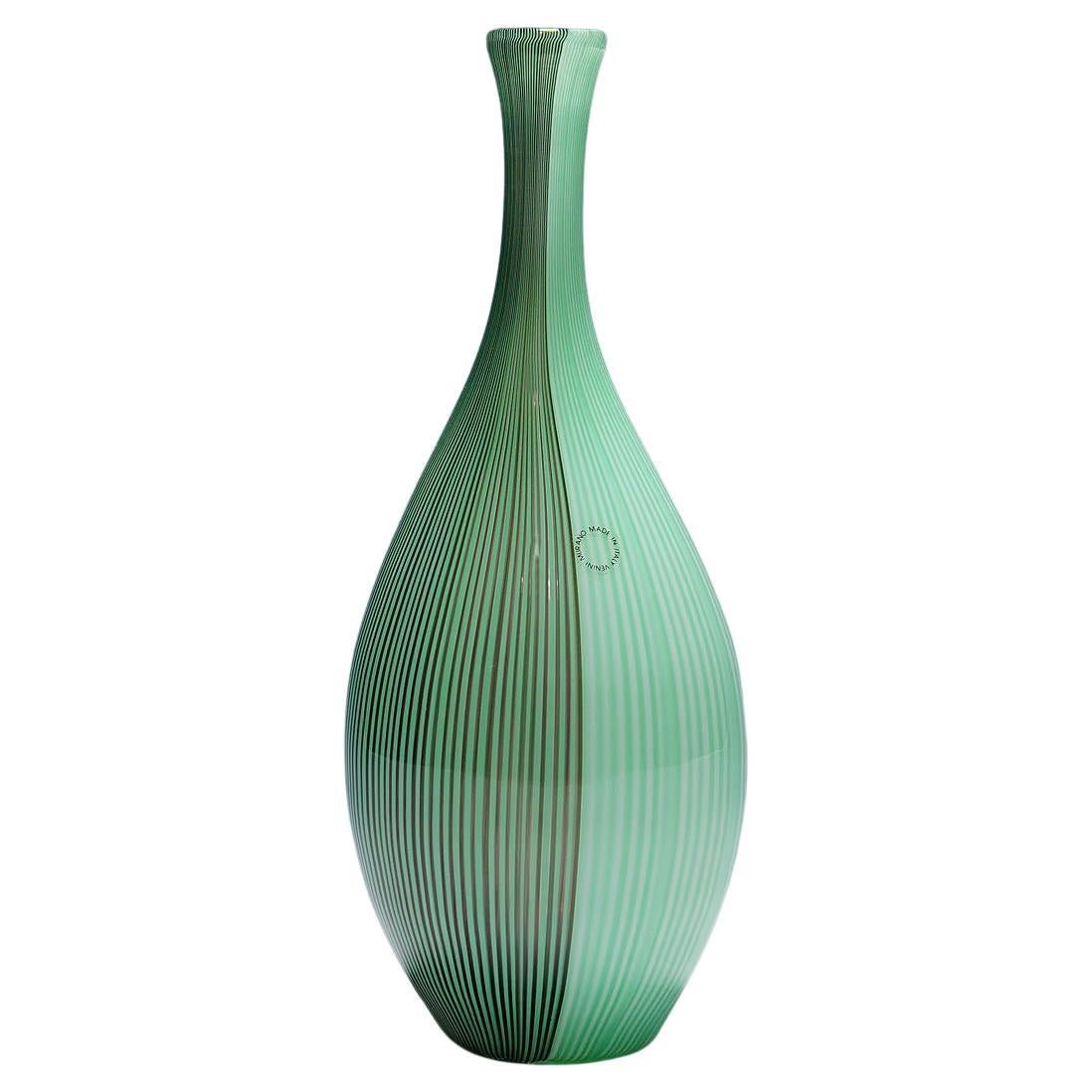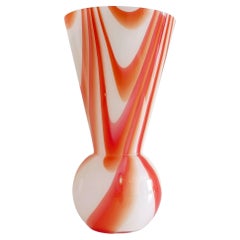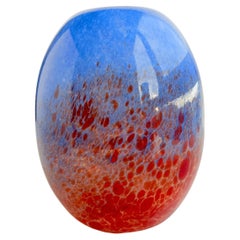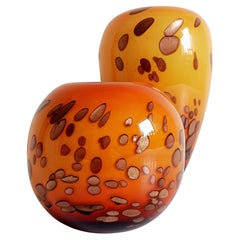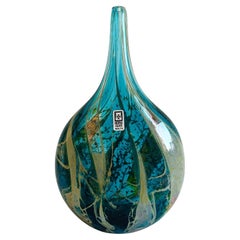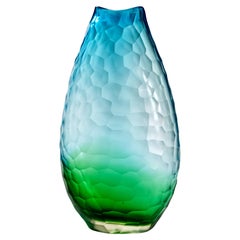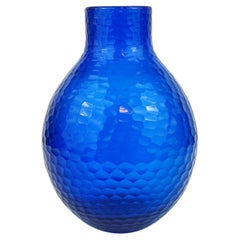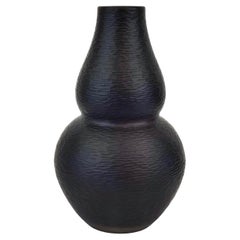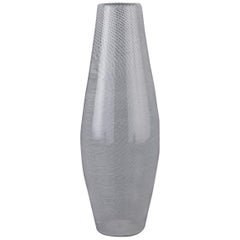Items Similar to Midcentury Carlo Scarpa for Venini Murano Glass Vase, Italy, 1960s
Video Loading
Want more images or videos?
Request additional images or videos from the seller
1 of 18
Midcentury Carlo Scarpa for Venini Murano Glass Vase, Italy, 1960s
About the Item
This Murano glass vase, designed by the renowned architect and designer Carlo Scarpa for Venini, exemplifies the mastery of mid-century Italian glassmaking. Hand-blown in the 1960s, the piece reflects Scarpa’s deep understanding of traditional Murano techniques, combined with his modernist sensibilities.
The vase features an elegant ovoid form, executed in a substantial size that commands attention. The light beige and amber hues, delicately interwoven, create a subtle yet dynamic interplay of color and transparency, characteristic of Venini’s refined aesthetic. The controlled gradation of tones enhances the organic quality of the piece, evoking the warmth and depth of natural materials.
Carlo Scarpa’s collaboration with Venini during the mid-20th century was instrumental in redefining Murano glass design. His meticulous approach to form, texture, and color resulted in some of the most sophisticated and sought-after glassworks of the era. This vase stands as a testament to his ability to bridge tradition and modernity, showcasing both technical prowess and artistic vision.
Dimensions:
Height: 31 cm (11.80 in)
Diameter: 20 cm (7.87 in)
Weight: 2 kg (4.4 lbs)
A piece of historical significance, this vase embodies the legacy of Italian glass artistry and the innovative spirit of one of the 20th century’s most influential designers.
Scarpa was born in Venice. Much of his early childhood was spent in Vicenza, where his family relocated when he was 2 years old. After his mother's death when he was 13, he moved with his father and brother back to Venice. Carlo attended the Academy of Fine Arts where he focused on architectural studies. Graduated from the Accademia in Venice, with the title of Professor of Architecture, he apprenticed with the architect Francesco Rinaldo.
Scarpa married Rinaldo's niece, Nini Lazzari (Onorina Lazzari). However, Scarpa refused to sit the pro forma professional exam administrated by the Italian Government after World War II. As a consequence, he was not permitted to practice architecture without associating with an architect. Hence, those who worked with him, his clients, associates, craftspersons, called him "Professor", rather than "architect".
His architecture was deeply sensitive to the changes of time, from seasons to history, rooted in a sensuous material imagination. He was Mario Botta's thesis adviser along with Giuseppe Mazzariol; the latter was the Director of the Fondazione Querini Stampalia when Scarpa completed his renovation and garden for that institution. Scarpa taught drawing and Interior Decoration at the "Istituto universitario di architettura di Venezia" from the late 1940s until his death.
While most of his built work is located in the Veneto, he made designs of landscapes, gardens, and buildings, for other regions of Italy as well as Canada, the United States, Saudi Arabia, France and Switzerland. His name has 11 letters and this is used repeatedly in his architecture. One of his last projects, the Villa Palazzetto in Monselice, left incomplete at the time of his death, was altered in October 2006 by his son Tobia. This work is one of Scarpa's most ambitious landscape and garden projects, the Brion Sanctuary notwithstanding. It was executed for Aldo Businaro, the representative for Cassina who is responsible for Scarpa's first trip to Japan.
Aldo Businaro died in August 2006, a few months before the completion of the new stair at the Villa Palazzetto, built to commemorate Scarpa's centenary. In 1978, while in Sendai, Japan, Scarpa died after falling down a flight of concrete stairs. He survived for ten days in a hospital before succumbing to the injuries of his fall. He is buried standing up and wrapped in linen sheets in the style of a medieval knight, in an isolated exterior corner of his L-shaped Brion Cemetery at San Vito d'Altivole in the Veneto. In 1984, the Italian composer Luigi Nono dedicated to him the composition for orchestra in micro-intervals A Carlo Scarpa, Architetto, Ai suoi infiniti possibili.
Venini—the world famous Italian glass company—traces it roots to 1921, when Paolo Venini (1895-1959), a Milan lawyer with glassmaking ancestors, and Giacomo Cappellin (1887-1968), a Venetian antiques dealer, launched the Cappellin Venini & C. glass factory on the island of Murano. Under the art direction of Vittorio Zecchin, Cappellin and Venini’s business produced high quality, Renaissance-style goblets, pitchers, and vases.
In 1925, following a dispute with Zecchin, Cappellin and Venini split their business in two. Venini’s business took the name Vetri Soffiati Muranesi Venini & C., along with a new, visionary art director, Napoleone Martinuzzi. Venini soon became synonymous with flamboyantly hued art glass and glass lighting at the cutting edge of contemporary aesthetics.
From 1927 to 1932, Venini explored a series of new, techniques—like pasta vitrea (opaque glass), vetro incamiciato (layered glass), and vetro pulegoso (bubble glass)—which engendered particularly experimental forms for the time. Venini’s reputation for innovation grew through exhibitions at national fairs, like the Venice Biennale, Monza, and eventually the Triennale di Milano. Around this time, Venini went into to partnership with Gio Ponti, Pietro Chiesa, Emilio Lancia, Michele Marelli, Tomaso Buzzi, and Carlo Visconti di Modrone to form Il Labirinto, an association for the promotion of modern design.
In 1932, Martinuzzi decided to dedicate himself to sculpture, and Venini’s artistic directorship went to architects Tomaso Buzzi and Carlo Scarpa. The modernist vision they brought to Venini represented an exciting, modernist turn for the company. Scarpa was particularly interested in capturing and amplifying light’s interaction with glass and was instrumental in developing new techniques like battuto (beaten glass), tessuto (glass with lines), granulare (glass with small globules), and murina (patterned glass made from rods).
Following World War II, Venini continued to produce glass in a modern idiom, frequently in collaboration with important midcentury designers and architects—not only Carlo Scarpa and Gio Ponti, but also BBPR, Fulvio Bianconi, Roberto Menghi, Tobia Scarpa, Massimo Vignelli, and Tapio Wirkkala. When Paolo Venini passed away in 1959, his company passed to his son-in-law, Ludovico Diaz De Santillan. In the 1970s, Ludovico’s daughter, Laura, managed the company, until the Gardini and Ferruzzi families acquired it in the mid-1980s.
Through the end of the 20th century, Venini continued to work with outstanding design talents, including Gae Aulenti, Mario Bellini, Alessandro Mendini, Timo Sarpaneva, and Ettore Sottsass. In 2001, Venini was acquired by Italian Luxury Industries. In the 21st century, the company has commissioned designs from the likes of Tadao Ando, Atelier Biagetti, Atelier Oï, Barber Osgerby, the Bouroullec brothers, the Campana brothers, Gaetano Pesce, Matteo Thun, and Studio Job.
In 2011, Venini celebrated its 90th anniversary with a travelling exhibition that visited the Glass Museum of Murano, Palazzo Grassi and Punta della Dogana in Venice, the Shanghai Museum of Glass, and the Bagatti Valsecchi Museum in Milan. The first exhibition dedicated to the glass produced by Carlo Scarpa for Venini was a critical and popular success in 2013-14 when it showed at Le Stanze del Vetro in Venice and The Metropolitan Museum of Art in New York. Venini glass can be found in the permanent collections of the Louvre, V&A, MoMA, and more.
- Attributed to:Venini (Manufacturer)Carlo Scarpa (Artist)
- Dimensions:Height: 12.21 in (31 cm)Diameter: 7.88 in (20 cm)
- Style:Organic Modern (In the Style Of)
- Materials and Techniques:
- Place of Origin:
- Period:
- Date of Manufacture:circa the 1960s
- Condition:
- Seller Location:Valencia, ES
- Reference Number:1stDibs: LU9319243399442
About the Seller
5.0
Platinum Seller
Premium sellers with a 4.7+ rating and 24-hour response times
Established in 2022
1stDibs seller since 2023
49 sales on 1stDibs
Typical response time: 1 hour
- ShippingRetrieving quote...Shipping from: Valencia, Spain
- Return Policy
Authenticity Guarantee
In the unlikely event there’s an issue with an item’s authenticity, contact us within 1 year for a full refund. DetailsMoney-Back Guarantee
If your item is not as described, is damaged in transit, or does not arrive, contact us within 7 days for a full refund. Details24-Hour Cancellation
You have a 24-hour grace period in which to reconsider your purchase, with no questions asked.Vetted Professional Sellers
Our world-class sellers must adhere to strict standards for service and quality, maintaining the integrity of our listings.Price-Match Guarantee
If you find that a seller listed the same item for a lower price elsewhere, we’ll match it.Trusted Global Delivery
Our best-in-class carrier network provides specialized shipping options worldwide, including custom delivery.More From This Seller
View AllMurano Glass Carlo Moretti Marbled Decor Vase, Italy, 1960s
By Carlo Moretti
Located in Valencia, VC
A Carlo Moretti beautiful marbled decor Murano glass vase in white and orange. Handmade in the island of Murano, near Venice, Italy, circa the 1960s.
A gorgeous, cheerful piece.
Di...
Category
Vintage 1960s Italian Mid-Century Modern Vases
Materials
Art Glass, Murano Glass
$419 Sale Price
20% Off
Murano Glass Vase by Anzolo Fuga for AVeM, Italy, 1960s
By Anzolo Fuga
Located in Valencia, VC
Murano glass vase attributed to Venice glass artist Anzolo Fuga for A.Ve.M. Handcrafted in the Murano island near Venice, Italy, circa the 1950s.
It is spectacular in the hand - the...
Category
Vintage 1960s Italian Mid-Century Modern Vases
Materials
Murano Glass
$614 Sale Price
50% Off
Murano Glass Cooper Gold Flecks Pair of Hand-Blown Vases, Italy, 1960s
By Cose Belle Cose Rare, Vintage Murano Gallery
Located in Valencia, VC
Pair of Mid-Century Murano Glass Vases, Orange Amber with Aventurine, circa 1960s
A striking pair of Mid-Century modern Murano blown glass vases, crafted in Italy in the 1960s. Thes...
Category
Vintage 1960s Italian Mid-Century Modern Vases
Materials
Gold Leaf
$1,181 Sale Price / set
30% Off
Midcentury Mdina Glass "Lollipop" Vase by Michael Harris, Malta, circa 1960s
By Michael Harris, Mdina
Located in Valencia, VC
Mdina Glass "Lollipop" Vase by Michael Harris, Malta, circa 1960s
A superb example of early Mdina Glass, designed by Michael Harris in the 1960s. After founding Mdina Glass in 1968 ...
Category
Vintage 1960s Maltese Mid-Century Modern Vases
Materials
Glass, Art Glass, Blown Glass
Bitossi Aldo Londi Midcentury Vintage Italian Large Ceramic Vase/Pitcher, 1960s
By Aldo Londi, Bitossi
Located in Valencia, VC
Rare Bitossi for Ceramiche Paoli Large Vase – Mid-Century Neolithic-Inspired Design
A striking example of Aldo Londi’s masterful work, this large ceramic vase embodies the timeless influence of Neolithic utility pottery, reinterpreted through Bitossi’s signature craftsmanship. Featuring the iconic sgraffito hand decor, inspired by Etruscan ceramics, this piece is part of the Sahara line, distinguished by its earthy, textured aesthetic. Unlike the standard Bitossi Sahara...
Category
Mid-20th Century Italian Mid-Century Modern Vases
Materials
Ceramic, Clay, Earthenware, Majolica, Stoneware
French Riviera Midcentury Rattan and Brass Basket Planter, Italy, 1960s
Located in Valencia, VC
A beautiful French Riviera brass rimmed handwoven basket planter, very in the style of Italian designer Gabriella Crespi. Handmade in Italy circa the 1960s-1970s.
Ideal as a planter...
Category
Mid-20th Century Italian Organic Modern Planters, Cachepots and Jardinières
Materials
Brass
You May Also Like
Battuto Ombre Vase Murano Glass Italy In Style of Carlo Scarpa for Venini
By Venini, Carlo Scarpa
Located in Clifton Springs, NY
Battuto series was designed by Carlo Scarpa for Venini in 1930s-1940s. In their presentation Battuto pieces depend on sculptural effect of the external shape and tactile and texture...
Category
21st Century and Contemporary Italian Organic Modern Vases
Materials
Glass, Art Glass, Murano Glass, Cut Glass
$580 Sale Price
20% Off
Carlo Scarpa 'Battuto' vase, Venini Murano Italy, 1940s
By Carlo Scarpa, Venini
Located in Bochum, NRW
Carlo Scarpa, 'Battuto' vase, 1940. Execution: Venini & C., Murano.
Height 19.5 cm.
The Venini’s artisans crafted this masterpiece from colorless glass with a striking blue underla...
Category
Vintage 1940s Italian Art Deco Vases
Materials
Murano Glass
Glass vase "Battuto" designed by Carlo Scarpa for Venini, Murano 1940s
By Venini, Carlo Scarpa
Located in Bochum, NRW
Carlo Scarpa, 'Battuto' vase, 1940
Height 23 cm.
Model No. 3922. Gourd shape. Execution: Venini & C., Murano.
Deep violet, almost black glass, encased in clear glass, with a hammer-...
Category
Vintage 1940s Italian Art Deco Vases
Materials
Murano Glass
Murano Glass Vase, attributed to Carlo Scarpa for Venini, circa 1930's
By Venini, Carlo Scarpa
Located in Roma, IT
Murano glass vase is a very rare vase realized attributed to the Italian architect and designer Carlo Scarpa for Venini glassworks, Murano circa 1930s.
Signed in acid stamp on the b...
Category
Vintage 1930s Italian Vases
Materials
Glass
Carlo Scarpa, La Mina Vase, Corroso Glass, Venini, Murano, Italy 1940s
By Carlo Scarpa, Venini
Located in Bochum, NRW
Murano Glass Vase 'La Mina' Vase designed by Carlo Scarpa for Venini in 1936.
Corroded iridized surface glass vase with protuberances "bugne". Venini Murano two lines acid signature...
Category
Vintage 1930s Italian Vases
Materials
Murano Glass
$6,332 Sale Price
20% Off
Large Tessuto Vase by Carlo Scarpa for Venini Murano
By Carlo Scarpa, Venini
Located in Berghuelen, DE
Large Tessuto Vase by Carlo Scarpa for Venini Murano
Item e7111
A rare example of the 'Tessuto' series designed by Carlo Scarpa ca. 1940. Manufactured by Venini Murano Venice. Thin v...
Category
Late 20th Century Italian Mid-Century Modern Vases
Materials
Art Glass, Murano Glass
Recently Viewed
View AllMore Ways To Browse
French Academy Drawing
Murano Glass Pitcher And Glasses
Vintage Barber Furniture
Hand Blown Glass Pitcher
Medieval Goblet
The Campana Brothers
Cappellin Venini
Murano Goblet
Vintage Barber Art
Lancia Emilio
Gaetano Pesce Up
Vintage Murano Goblet
Venetian Glass Goblets
Mario Villa Furniture
Mario Villa
Carlo Scarpa Pitcher
Vintage French Exterior Lighting
Amber Glass Goblet
